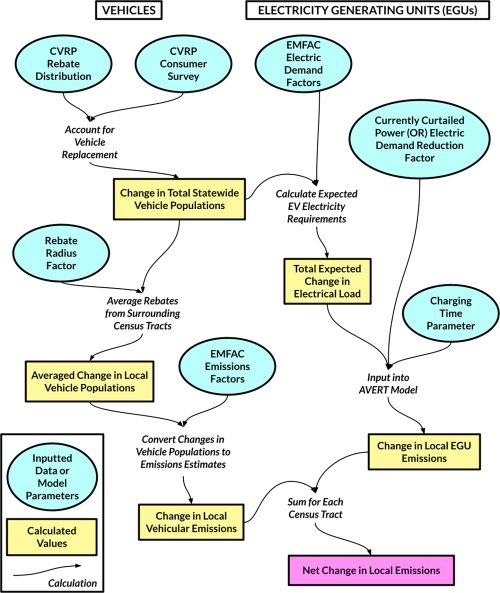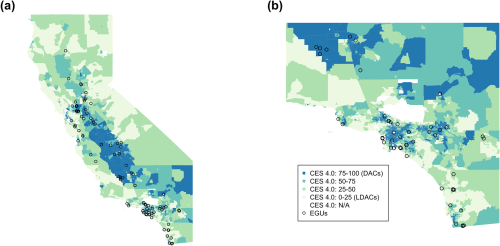In an open-access paper published in PLOS Climate, the team reports that CVRP reduced aggregate statewide emissions of CO2, NOx, and SO2. However, the results indicate that the CVRP has displaced emissions from vehicle tailpipes to electric generating units (EGUs), leading to a net increase in primary PM2.5 emissions across the state of California.

The air pollution implications of electric vehicle rebates were modeled according to this schematic. Blue boxes represent data inputs and model parameters, including the current Clean Vehicle Rebate Project rebate distribution, the EMFAC (Emission Factors) model, and the Clean Vehicle Rebate Project consumer survey. Yellow boxes represent calculated values, with the calculations described correspondingly in the methods section. Italicized text summarizes the calculations performed to convert blue inputs into yellow calculated values. The model was used to evaluate emissions changes under 4 scenarios. Mejia-Duwan et al.
The results further indicate that, as a result of the CVRP, net primary increases in PM2.5, and NOx, and SO2 emissions reductions disproportionately occur in Least Disadvantaged Communities, as compared to Disadvantaged Communities, with community disadvantage defined according to CalEnviroScreen 4.0 per California legislation.
In other words, the Disadvantaged Communities are disproportionately more likely to experience either larger net increases or smaller net reductions in primary PM2.5, NOx, and SO2 emissions as a result of the CVRP.

In California, electricity generating units (EGUs) are disproportionately located in disadvantaged communities. Panel (a) presents statewide data and panel (b) presents a regional example, centered on the city of Los Angeles in Southern California. Black circles represent the 231 EGUs in the state of California catalogued by the 2020 AVERT (Avoided Emissions and Generation Tool) model. Census tracts are divided into 4 quartiles based on CalEnviroScreen 4.0 (CES 4.0) percentile score, with higher CES 4.0 percentile scores corresponding to a darker background. Disadvantaged Communities (DACs) are defined as having CES 4.0 scores in the highest quartile for the state, while Least Disadvantaged Communities (LDACs) are defined as having CES 4.0 scores in the lowest quartile. This map was produced in R using United States Census Bureau 2010 TIGER/Line Shapefiles. Mejia-Duwan et al.
Vehicle electrification is expected to reduce, in aggregate, emissions of greenhouse gases and criteria air pollutants. However, increased electricity generation to support new electric vehicles introduces possible redistribution of point-source emissions from mobile vehicles to electric generating units such that emissions may decrease in some locations and increase in others, with implications for equity.
… If the current spatial distribution of electric vehicle rebates remains unchanged, we project that these inequities will continue through the state’s legislative goal of 1.5 million zero-emission vehicles on California roadways by 2025, even with increased cleanliness of the electricity sources for new vehicles. Increased uptake of electric vehicles in communities facing the highest air pollution exposure, along with accelerated clean-energy generation, could ameliorate associated environmental inequities.
—Mejia-Duwan et al.